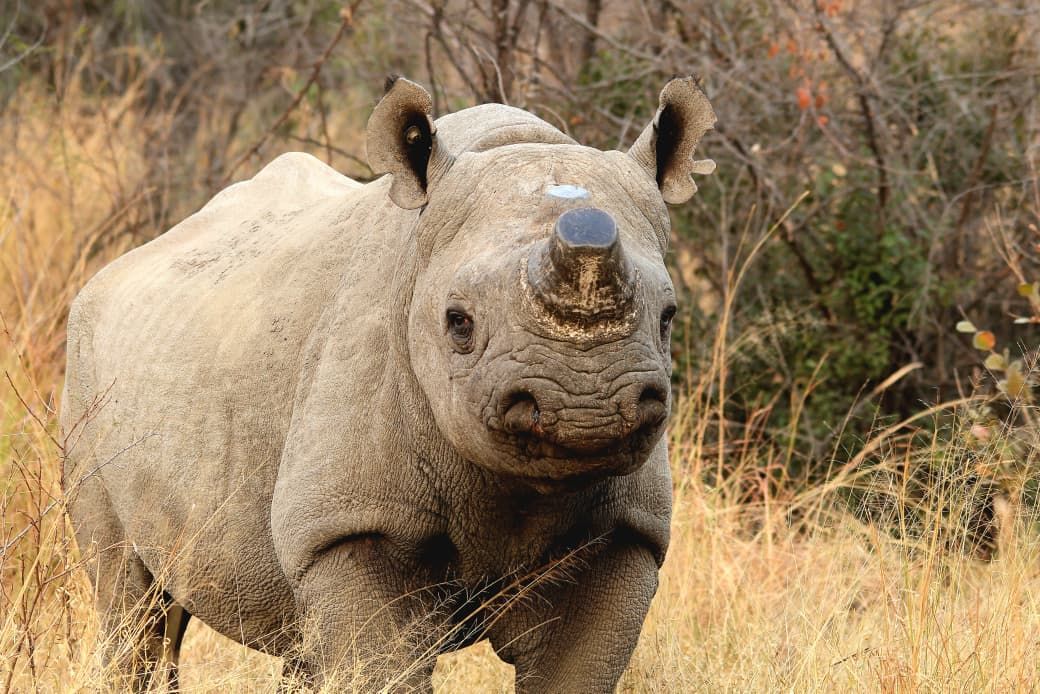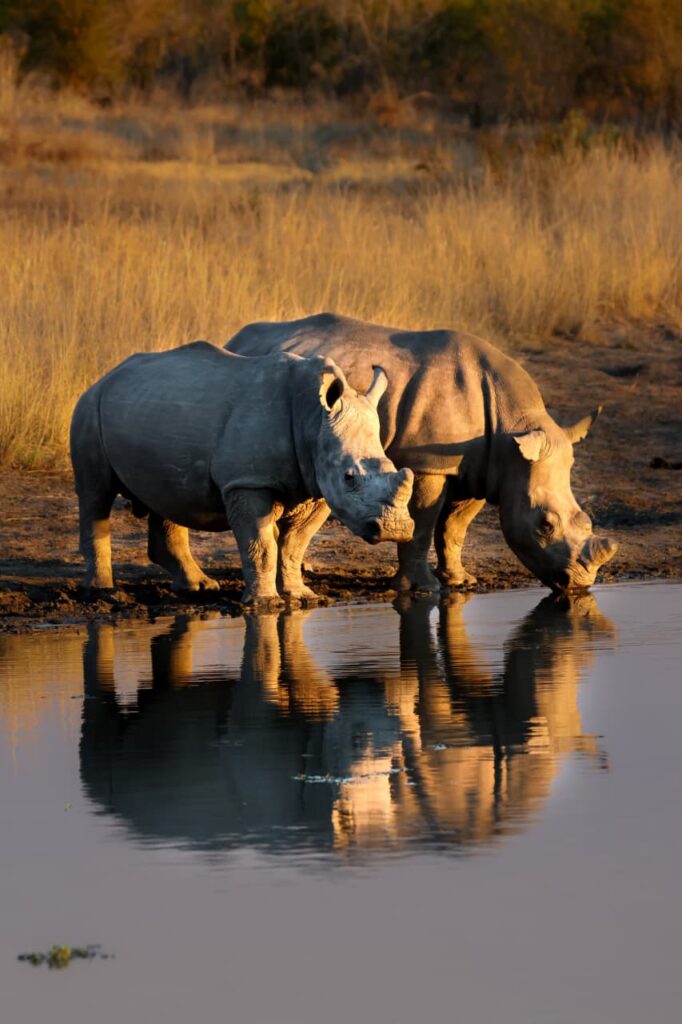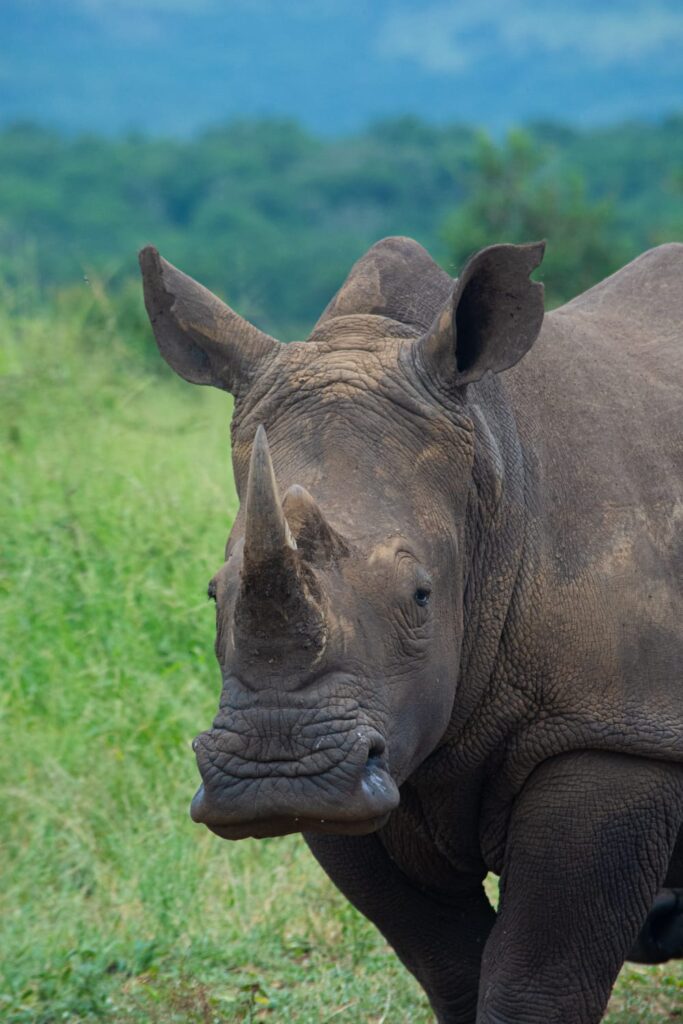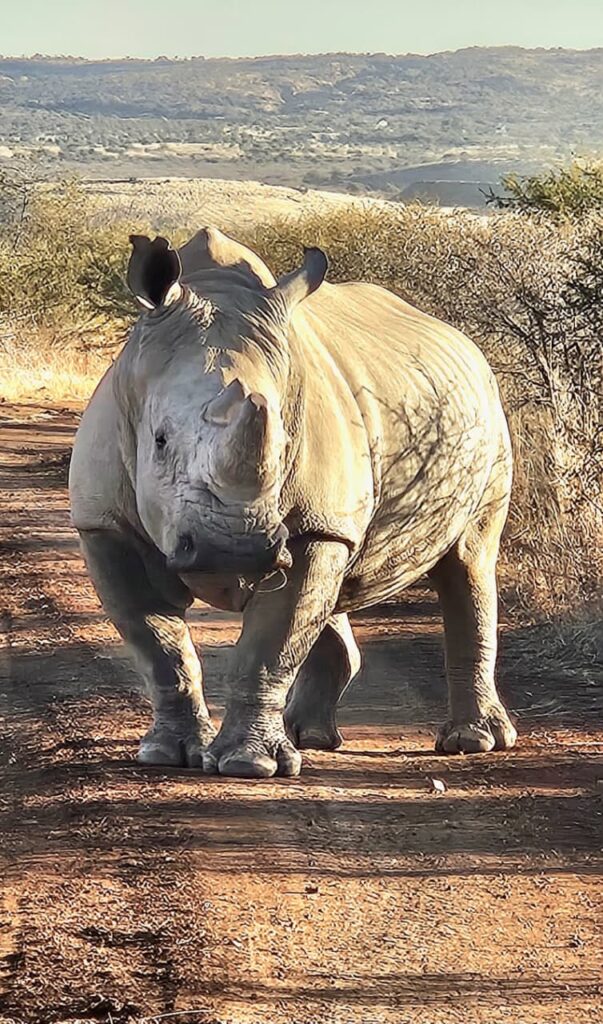
Guardians of the Bushveld – A Tribute to Africa’s Black & White Rhinos
The morning sun spills gold across the African savanna, casting long shadows of ancient giants.
Two silhouettes move silently through the mist — one wide-mouthed and grazing the dew-damp grass, the other head raised, lips reaching for leaves.
They are Africa’s grey ghosts: the Black Rhino and the White Rhino.
They have survived ice ages, predators, and centuries of change… but today, their greatest challenge comes from humankind.
Every 22 September, the world unites for World Rhino Day — not just to admire their beauty, but to remember that without urgent protection, these extraordinary creatures could vanish within our lifetime.
Two Species, One Continent
Africa is home to two distinct rhino species: the White Rhino and the Black Rhino. While their names might suggest differences in colour, both are actually grey — it’s their shape, diet, and behaviour that set them apart.

The White Rhino – The Grassland Grazer
The White Rhino is the larger of the two, weighing up to 2,300 kg — about the size of a small car. Its broad, square-shaped mouth is perfectly adapted for grazing short grasses, like a living lawnmower of the savanna.
The name “White Rhino” is believed to have come from a mistranslation of the Afrikaans word “wyd” meaning wide, referring to their mouth shape, not their colour.
They are the gentle giants of the rhino world — more social than their black counterparts, often seen in small groups, especially mothers with calves. Calm in nature but fiercely protective when threatened, the White Rhino is a symbol of quiet strength.
The Black Rhino – The Bushland Browser
Slightly smaller, at around 1,400 kg, the Black Rhino is stockier and more compact. Its pointed, prehensile upper lip acts like a finger, grasping leaves, branches, and fruit from bushes and trees.
Black Rhinos are generally solitary, and their reputation for being aggressive often stems from their poor eyesight. Startling easily, they may charge first and investigate later — a behaviour that has helped them survive predators, but tragically makes them vulnerable to poachers.
Conservation Status – From the Brink of Extinction
Both species have endured devastating losses due to poaching for their horns, which are falsely believed to have medicinal value in some cultures, and habitat destruction as human settlements expand.
- White Rhino:
- Southern White Rhino – A rare conservation success story. From fewer than 100 individuals in the early 1900s, their numbers have risen to over 16,000 today through intensive protection. Still, they are listed as Near Threatened.
- Northern White Rhino – Tragically, only two females remain, both under constant armed guard. Without groundbreaking scientific intervention, this subspecies is functionally extinct.
- Black Rhino:
Once numbering over 65,000 in Africa, Black Rhino populations crashed by 98% between 1960 and 1995. Today, thanks to dedicated conservation, numbers are slowly increasing to around 6,500, but they remain Critically Endangered.

Why Rhinos Matter
Rhinos are more than just icons of African wildlife — they are ecosystem engineers.
- White Rhinos keep grasslands neatly trimmed, encouraging the growth of nutritious new shoots that feed other grazers like zebra and wildebeest.
- Black Rhinos prevent bush encroachment by feeding on woody plants, allowing sunlight to reach the soil and creating space for grasses and herbs to thrive.
If rhinos disappeared, the ecosystems they help maintain would begin to change — and with them, countless other species would be affected.
The Human Connection
Rhinos have walked this earth for over 50 million years. They are part of our shared heritage — creatures that have inspired ancient rock art, folklore, and modern conservation movements. Losing them would not only be a loss to biodiversity, but to culture, history, and identity.
World Rhino Day is a reminder that protecting wildlife is not a choice for future generations — it’s our responsibility today.
How You Can Help Protect Rhinos
Conservation is not just the work of rangers and scientists — it’s something we can all be part of:
- Support Rhino Protection Initiatives
Contribute to reputable conservation organisations that fund anti-poaching units, veterinary care, and habitat restoration. - Responsible Tourism
Visit reserves and lodges that actively protect rhinos. Your tourism supports local communities and funds conservation efforts. - Spread Awareness
Share the truth about rhino poaching and the myths surrounding rhino horn. Education is one of the most powerful tools against illegal wildlife trade. - Refuse and Report Wildlife Products
Never purchase or support the sale of rhino horn products. Report suspicious wildlife trade activity to authorities.

A Shared Future
Imagine a future where your grandchildren can stand in the golden dawn light and watch a rhino graze quietly on the open plains, as people have for countless generations. That future is still possible — but only if we act now.
On this World Rhino Day, let’s not just admire these magnificent animals from afar. Let’s commit to protecting them, speaking for them, and ensuring that their thundering footsteps continue to echo across Africa’s wild landscapes for generations to come.
“The only way to save a rhinoceros is to save the environment in which it lives, because there’s a mutual dependency between it and millions of other species of both animals and plants.” — Sir David Attenborough

